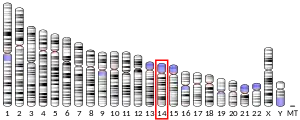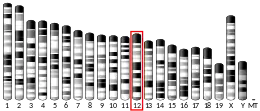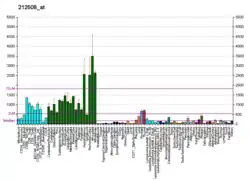MOAP1
Modulator of apoptosis 1 is a protein that in humans is encoded by the MOAP1 gene.[5][6]
The protein encoded by this gene was identified by its interaction with apoptosis regulator BAX protein. This protein contains a Bcl-2 homology 3 (BH3)-like motif, which is required for the association with BAX. When overexpressed, this gene has been shown to mediate caspase-dependent apoptosis.[6]
References
- ENSG00000278268 GRCh38: Ensembl release 89: ENSG00000165943, ENSG00000278268 - Ensembl, May 2017
- GRCm38: Ensembl release 89: ENSMUSG00000096458 - Ensembl, May 2017
- "Human PubMed Reference:". National Center for Biotechnology Information, U.S. National Library of Medicine.
- "Mouse PubMed Reference:". National Center for Biotechnology Information, U.S. National Library of Medicine.
- Tan KO, Tan KM, Chan SL, Yee KS, Bevort M, Ang KC, Yu VC (May 2001). "MAP-1, a novel proapoptotic protein containing a BH3-like motif that associates with Bax through its Bcl-2 homology domains". J Biol Chem. 276 (4): 2802–7. doi:10.1074/jbc.M008955200. PMID 11060313.
- "Entrez Gene: MOAP1 modulator of apoptosis 1".
Further reading
- Hartley JL, Temple GF, Brasch MA (2001). "DNA cloning using in vitro site-specific recombination". Genome Res. 10 (11): 1788–95. doi:10.1101/gr.143000. PMC 310948. PMID 11076863.
- Simpson JC, Wellenreuther R, Poustka A, et al. (2001). "Systematic subcellular localization of novel proteins identified by large-scale cDNA sequencing". EMBO Rep. 1 (3): 287–92. doi:10.1093/embo-reports/kvd058. PMC 1083732. PMID 11256614.
- Strausberg RL, Feingold EA, Grouse LH, et al. (2003). "Generation and initial analysis of more than 15,000 full-length human and mouse cDNA sequences". Proc. Natl. Acad. Sci. U.S.A. 99 (26): 16899–903. doi:10.1073/pnas.242603899. PMC 139241. PMID 12477932.
- Ota T, Suzuki Y, Nishikawa T, et al. (2004). "Complete sequencing and characterization of 21,243 full-length human cDNAs". Nat. Genet. 36 (1): 40–5. doi:10.1038/ng1285. PMID 14702039.
- Gerhard DS, Wagner L, Feingold EA, et al. (2004). "The status, quality, and expansion of the NIH full-length cDNA project: the Mammalian Gene Collection (MGC)". Genome Res. 14 (10B): 2121–7. doi:10.1101/gr.2596504. PMC 528928. PMID 15489334.
- Wiemann S, Arlt D, Huber W, et al. (2004). "From ORFeome to biology: a functional genomics pipeline". Genome Res. 14 (10B): 2136–44. doi:10.1101/gr.2576704. PMC 528930. PMID 15489336.
- Baksh S, Tommasi S, Fenton S, et al. (2005). "The tumor suppressor RASSF1A and MAP-1 link death receptor signaling to Bax conformational change and cell death". Mol. Cell. 18 (6): 637–50. doi:10.1016/j.molcel.2005.05.010. PMID 15949439.
- Rual JF, Venkatesan K, Hao T, et al. (2005). "Towards a proteome-scale map of the human protein-protein interaction network". Nature. 437 (7062): 1173–8. Bibcode:2005Natur.437.1173R. doi:10.1038/nature04209. PMID 16189514. S2CID 4427026.
- Vos MD, Dallol A, Eckfeld K, et al. (2006). "The RASSF1A tumor suppressor activates Bax via MOAP-1". J. Biol. Chem. 281 (8): 4557–63. doi:10.1074/jbc.M512128200. PMID 16344548.
- Mehrle A, Rosenfelder H, Schupp I, et al. (2006). "The LIFEdb database in 2006". Nucleic Acids Res. 34 (Database issue): D415–8. doi:10.1093/nar/gkj139. PMC 1347501. PMID 16381901.
- Lim J, Hao T, Shaw C, et al. (2006). "A protein-protein interaction network for human inherited ataxias and disorders of Purkinje cell degeneration". Cell. 125 (4): 801–14. doi:10.1016/j.cell.2006.03.032. PMID 16713569.
- Fu NY, Sukumaran SK, Yu VC (2007). "Inhibition of ubiquitin-mediated degradation of MOAP-1 by apoptotic stimuli promotes Bax function in mitochondria". Proc. Natl. Acad. Sci. U.S.A. 104 (24): 10051–6. Bibcode:2007PNAS..10410051F. doi:10.1073/pnas.0700007104. PMC 1877986. PMID 17535899.
This article is issued from Wikipedia. The text is licensed under Creative Commons - Attribution - Sharealike. Additional terms may apply for the media files.




